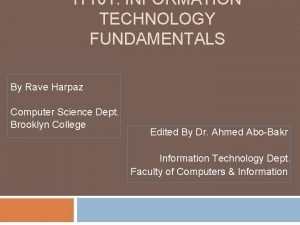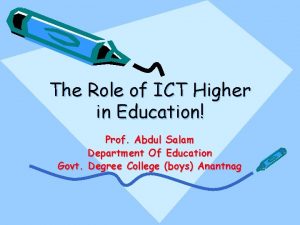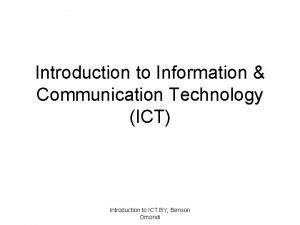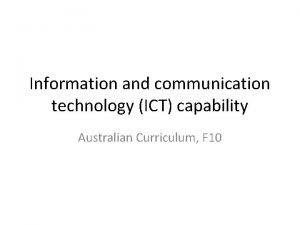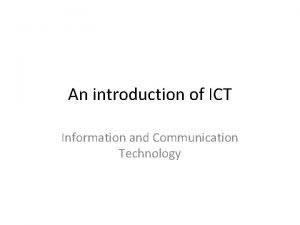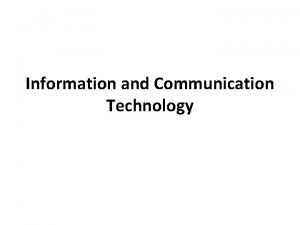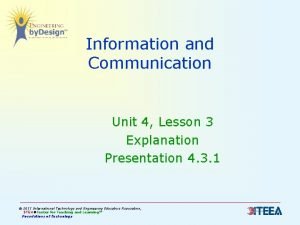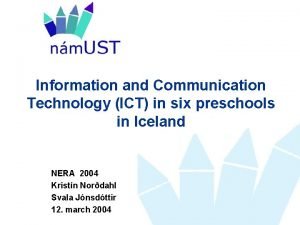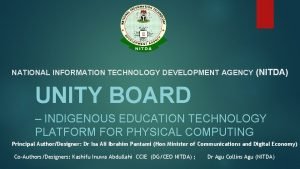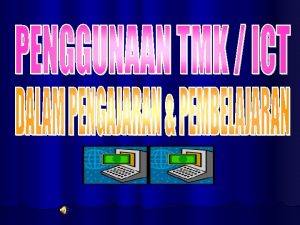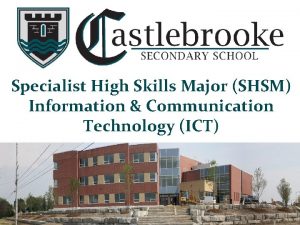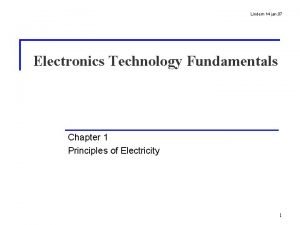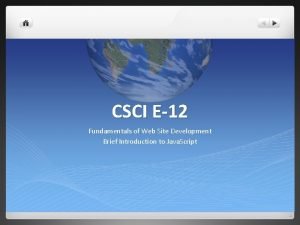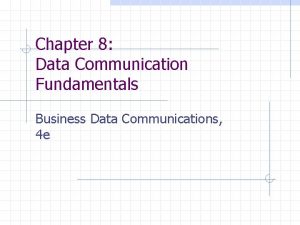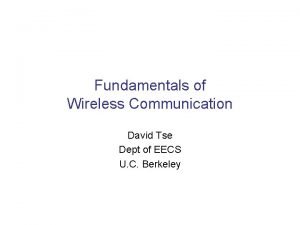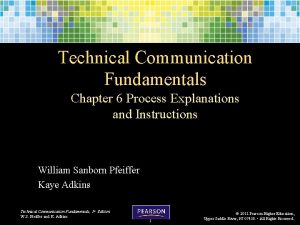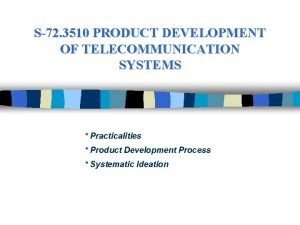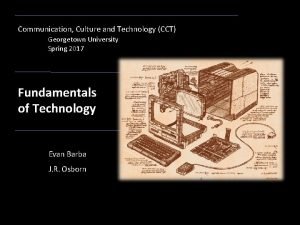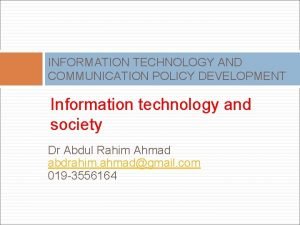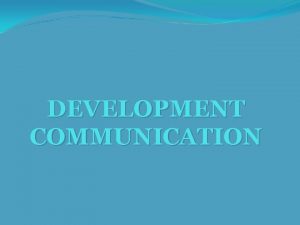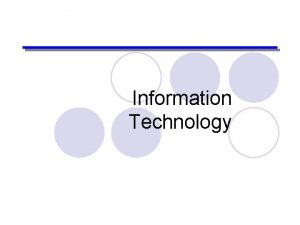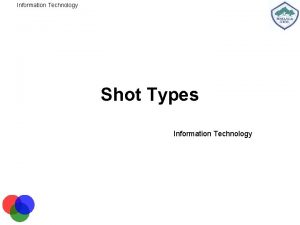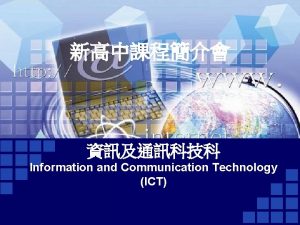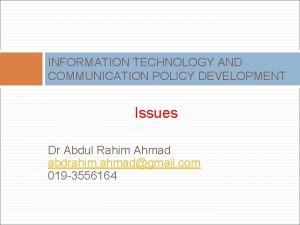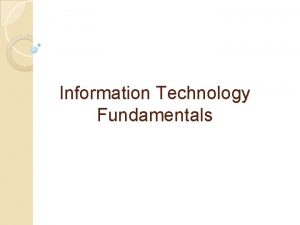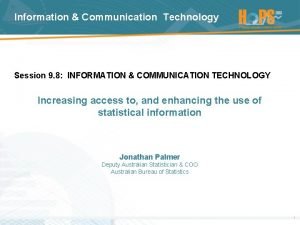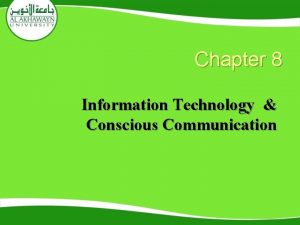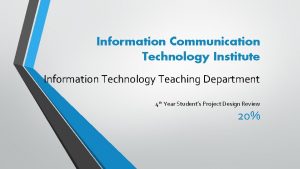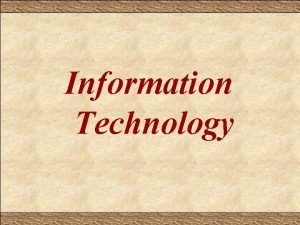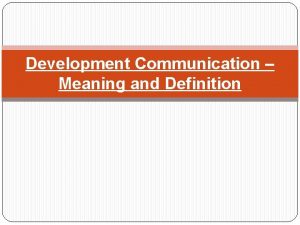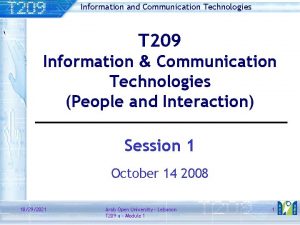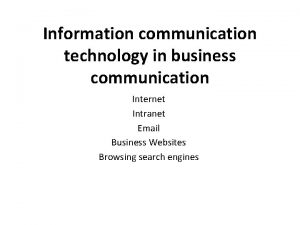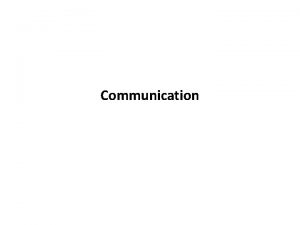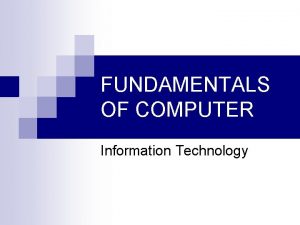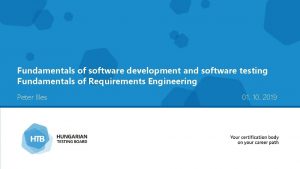INFORMATION TECHNOLOGY AND COMMUNICATION POLICY DEVELOPMENT Fundamentals Dr






























- Slides: 30

INFORMATION TECHNOLOGY AND COMMUNICATION POLICY DEVELOPMENT Fundamentals Dr Abdul Rahim Ahmad abdrahim. ahmad@gmail. com 019 -3556164

Summary IT Policy Development Theoretical and practical perspectives on ICT policy Formulation Implementation evaluation. Topics Dimensions of ICT Policy, Approach in IT Policy implementation Economic and social impact of IT policy initiatives.

IT – Technology Perspective “all technology that enable the acquisition, storage, processing, transmission and presentation of information, with the involvement of primary technologies such as microelectronics, computers, telecommunications and software technology. Freeman (1987)” “a combination of new technology developments in microelectronics, computers, optoelectronics and communications systems, which collectively are having such pervasive effects that many people have talked in terms of a paradigm change in technology”

IT – Economic Perspective Freeman and Soete (1985) "A new techno-economic paradigm affecting the management and control of production and service systems throughout the economy, based on an interconnected set of radical innovations in electronic computers, software engineering, control systems, integrated circuits and telecommunications, which have drastically reduced the cost of storing, processing, communicating and disseminating information. It comprises a set of firms and industries supplying new equipment and software, but its development and new applications are not limited to this specialized IT sector".

IT - Technical and Cognitive T. M. A Shariffadeen (1994) Information Technology: Collection of technologies based on microelectronics, computers and telecommunications that enhance the process of acquiring, storing, processing, transmitting, presenting and applying information for human development and progress Two dimensions Technological: interconnection of computers through telecommunications networks to enhance information flow (availability, accessibility, usefulness) Cognitive: application of human understanding and cognition to enhance intelligence in design, production and delivery of goods and services

ICT – The convergence (Up to 2000)

ICT Facts Rapidly evolving. Affects to society social change New, competing and conflicting demands within society Fuels globalization Allows access to information and knowledge K-worker and K-economy New area of innovation and entrepreneurship Use, misuse and abuse of information

ICT - Agent of Change cyberspace access to global market ‘fluid’ money greater communication & collaboration access to vast amounts of information prospect of creating a Digital Divide new environment of control - new businesses & new business models more markets and greater competition faster online transactions greater knowledge flows and increased innovation faster and greater learning greater disparity between the ‘haves’ and ‘have-nots’; potential negative side ICT needs to be used for positive development

ICT - The impact ICT has potential benefits and potential problems. ICT investments can either: bring high economic and social returns OR results in enormous waste or even catastrophic loss. There are ‘winners’ and there can be ‘losers’ unless steps are taken to prevent such developments. Therefore, a sound public policy direction can increase the possibilities for benefit reduce the risks of loss and harm ensure that the implications for all sectors of society are considered as steps toward an information society are taken “

ICT Policy

Freeman and Perez There has been a 'techno-economic paradigm shift' that is reshaping the economic environment which is creating an information society, in which ICT is the central driving force. ”

Technology Policy Edquist: two categories of Technology Policy. direct (explicit): … policies in the form of government intervention expressly intended to influence the process of technical change e. g. R&D subsidies, dissemination of information about new technologies to the public. indirect (implicit): . . policies that are primarily designed to influence technical change, but which influence technical change to a greater or lesser extent anywhere e. g. trade policies, exhange rate policy, military security policy, industrial policy and fiscal policy.

Technology Policy Ergas and Brooks: 3 groups of interactions between technological system and government policy : “Mission-oriented” - focus on radical innovations needed to achieve clearly set out goals of national importance. “Diffusion-Oriented” – diffuse technological capabilities throughout the industrial structure, thus facilitating the ongoing and mainly incremental adaptation to change. Combination between “Mission-oriented and Diffusion-oriented”

Technology Policy – Aim & Role Aim Grow employment opportunities Increase per capita income Reduce economic dependence on other countries Even Distribution of income Reduce environmental damage associated with development Role Improve efficiency of technology transfer Improve efficiency of assimilation and operation of technology Broadening and strengthening industrial base Promote emergence of indigenous technological capability Smoothing the “adjustment” process

IT Policy Definition : “Actions by public authorities that have effects on IT use”. Taken by public authorities, which have an effect on IT development, its utilization or its consequences. Examples: Ministry responsible for industry may have policies for the promotion of the use of IT (including microelectronics) in industrial sectors Ministry of Agriculture may promote the modernization/rationalization of management of farms be integrating the usage computerized on-line information systems. Policies for IT training for students and/or workers, IT R&D Rules for the use of personal data via electronic information systems and intellectual property rights on software” (OECD, 1992)

IT Policy - Options Demand-side actions Typically include the use of monetary incentives to encourage adoption, such as subsidies for investment in new types of computer system, e. g. CAD (Computer-Aided Design). Two purposes; to improve the efficiency of non-IT branches by promoting the use of IT, to stimulate demand for nationally-made IT products, to the benefit of producing firms. Bridging Standardisation - provides a vital bridge between demand- and supply-side actions. Agreed standards speed the diffusion of IT by removing important elements of uncertainty from adopters' investment decisions and by increasing the benefits available through interworking of the different information technologies. Supply-side actions Supply-side policies - divide between relatively traditional forms of state industrial policy and innovation policy.

ICT Policy - Roles The dual role: as a production sector and as an enabler targeting economic development targeting socio-economic development Application of ICT in other areas; industries such as banking and energy, services such education and health ICT itself as an industry in its own right, such as computer hardware, software, telecommunication, multimedia and semiconductors

Development Stages INDUSTRIAL SOCIETY manufacturing & DEVELOPING processing PRIMITIVE SOCIETY hunting & gathering Labour Source: NITA, 1996 LEAST SOCIETY DEVELOPED SOCIETY agricultural shifting & farming Labour + Land & mining Labour + Land + Capital POST- INDUSTRIAL / ADVANCED INDUSTRIAL SOCIETY DEVELOPED SOCIETY manipulating & control recycling & synthesizing knowledge services information services Labour +Land + Capital +Entrepreneur utility + Labour + services Information + R&D + Land + Technology + Capital + Labour + Knowledge Entrepreneur + Land + Capital + Information + R&D + Entrepreneur + Technology Information E G IO OR T C A NF IN MAT R O F HAN OF C

ICT Policy - Framework AN EFFECTIVE ICT POLICY FRAMEWORK HAS 4 MAIN COMPONENTS: PLANNING, FACILITATION, INTERVENTION, AND MONITORING • Source: Team analysis Planning – – ICT strategy ICT coordination/ facilitation • • Facilitation – – Regulation Tax/financial incentives • Intervention • Industry development – – Local companies Foreign companies/FDI • Capability development – – Education in S&T Specialized ICT training • Infrastructure development – – – Telecom Internet Physical infrastructure • Technology development – – Research institutes Private/corporate R&D • Societal development – – Social projects Public sector projects • Special projects – Cross-disciplinary; ICT alignment of other sectors Monitoring

PLANNING • Objectives – Develop national ICT strategy – Coordinate/ facilitate implementatio n of “Intervention” initiatives • Key initiatives • • – Develop and author strategic ICT Roadmap ICT Strategy ICT coordination/ facilitation – Set up structure and mechanism for key stakeholders to debate and decide on key ICT focus areas built around distinctive centers of excellence in technology – Translate these top-line strategies into concrete action plans, based on the 6 pillars of intervention, i. e. , which industries to promote and what specific companies to attract, what technology sub-sectors to pursue, what additional infrastructure to build, and what national/social ICT projects to focus the nation in this direction – Coordinate and facilitate “Intervention” activities; i. e. industry development, capability development, infrastructure development , technology development, and ICT special projects – guide, but not lead projects directly – Define “who does what” – Ensure setting and monitoring of tangible milestones Source: Team analysis

FACILITATION • Objectives – Create appropriate regulatory environment conducive for industry growth – Institute attractive tax and other financial incentives to draw in companies Source: Team analysis • Key initiatives • Regulations • Tax/financial incentives – Define telecom regulations to foster development of world-class telecom infrastructure and communica-tion services – Provide appropriate content and media regulations to facilitate creation and aggregation of online content and applications – Ensure regulatory framework fosters development of competitive and highperforming, but also economically healthy industry structures – Establish progressive legal environment for ICT, e. g. facilitate online trading – Work with Treasury to institute attractive tax and other financial incentives relative to other countries – Facilitate offering of tailored incentives for high-priority foreign companies – Create, if necessary, additional incentives to encourage local companies to set up high value-adding activities, e. g. design and R&D

INTERVENTION: INDUSTRY DEVELOPMENT • Objectives – Build and grow innovative local ICT companies – Attract FDI (Foreign Direct Investment), especially from leading foreign companies Source: Team analysis • Key initiatives • Local companies • Foreign companies – Encourage entrepreneurial activities to start up more local ICT companies, e. g. business plan competition – Facilitate technology transfer from foreign players to local companies – Help local companies move-up ICT “Innovation” value chain – Help local companies expand beyond local markets – Help foreign companies set up sizeable and meaningful operations – Encourage foreign companies to bring in more value-added activities (e. g. regional headquarters, design, R&D in Malaysia) – Advise foreign companies on Government-related matters

INTERVENTION: CAPABILITY DEVELOPMENT • Objectives – Enhance education system to produce highquality science and technology talent pool – Provide specialized ICT training/certificatio n programs to meet short to medium term needs Source: Team analysis • Key initiatives • Science & technology education • Specialize d ICT training – Enhance tertiary education in relevant technical and business areas to create close alignment with ICT needs – Help universities plan class intakes based on projected needs for ICT graduates – Further improve primary and secondary education, ensuring long-term competitiveness of talent pool – Catalyze establishment of specialized ICT training institutes that offer international certification programs – Foster setting up of part-time ICT courses to upgrade skills of existing working professionals – Provide, if necessary, financial and other incentives to encourage private companies to train staff in ICT areas

INTERVENTION: INFRA DEVELOPMENT • Objectives – Provide worldclass and competitive telecom infrastructure – Upgrade domestic and international Internet connectivity – Provide highquality physical infrastructure for ICT industry Source: Team analysis • Key initiatives • Telecom • Internet connectivi ty • Physical infrastruc ture – Invest, if necessary, to build world-class telecom infrastructure – Proactively attract leading telecom players to build and upgrade telecom infrastructure and provide advanced communication services – Continuously monitor domestic and international Internet pipes, and upgrade when needed – Ensure availability of redundancy in connectivity – Ensure availability of connectivity for everybody, including rural and underprivileged – Set aside, and develop high quality physical infrastructure for ICT industry – Aggregate enough players to create vibrant ICT clusters, especially in MSC, and facilitate relocation of “anchor tenants” if necessary

INTERVENTION: TECHNOLOGY DEVELOPMENT • Objectives – Build worldclass ICT Research institutes – Promote privatelyfunded Research and Development Source: Team analysis • Key initiatives • Research Institutes • Private/ Corporate R&D – Identify, in alignment with national ICT strategic needs, key ICT technologies to focus on – Develop and import where necessary top talent to build world-class Research institutes in chosen technology areas – Create tight linkages between Research institute and ICT industry – Provide financial and other incentives to encourage companies to set up R&D in ICT areas – Help ICT companies collaborate with Research institutes

INTERVENTION: SOCIETAL DEVELOPMENT • Objectives – Promote social development through ICT • Key initiatives • Social Projects – Implement public sector projects • Public Sector Projects Source: Team analysis – Set up projects to fulfill specific social agenda of nation, e. g. , Digital Divide in Malaysia – Organize public seminars/conferences to create awareness in “new” ICT technology – Accelerate adoption of “new” ICT technology by Government agencies – Continue E-Government initiative to provide and deliver enhanced public service

INTERVENTION: SPECIAL PROJECTS • Objectives – Implement special cross disciplinary projects to accelerate ICT adoption, especially in non-ICT sectors Source: Team analysis • Key initiatives • Special Projects – Set up test-bed projects for “new” ICT technology, e. g. , wireless, broadband, smart homes, telemedicine, etc. – Set up projects that spans multiple areas and require coordination between multiple Government agencies – Promote new ICT technology and standards in special interest groups, e. g. , supply-chain for E&E, XML for e-business, open source – Identify gaps in areas not covered by other “sections” and initiate projects to close gaps

MONITORING • Objectives – Set up progress monitoring mechanism s against tangible milestones defined in “Planning” Source: Team analysis • Key initiatives • Monitoring – Identify and clearly define critical implementation targets and milestones. Ensure consistent definition of performance indicators and targets across various agencies – Setup and maintain systems to monitor progress against targets and milestones – measure progress independently and objectively – Provide feedback to “Planning” to continuously update and refine strategy and – Communicate feedback pro-actively and constructively to implementation agencies – Assist agencies in refining/revising strategies based on progress and changes in environment – Coordinate regular (every 6 months) review meeting to determine next steps

References Arnold, E. & Guy. K. (1987), Information Technology and Emerging Growth Areas, Science Policy Research Unit, University of Sussex. Arnold, E. and Guy, K. (1991). “Diffusion Policies for IT: The Way Forward. ” Summary Paper: Based on an ad hoc Meeting of the OECD/ICCP Expert Group on the Economic Implications of Information Technologies, Paris, 7 -8 November. Bessant, J. , Guy, K. , Miles, I. , and Rush, H. (1986). IT Futures Surveyed, NEDO, London. Dutton, W. H. , Blumber, J. G. , Garnham, N. , Mansell, R. , Cornford, J. and Peltu, M. (1996). “The Politics of Information and Communication Policy: The Information Superhighway, ” In Dutton, W. H. (ed. ), Information and Communication Technologies: Visions and Realities, Oxford University Press, Oxford.

References Edquist, C (1990), Technology Policy, “Social, Economic and Political Aspects”, Department of Technology and Social Change, Sweden. Ergas, H. (1987), “Does Technology Policy Matter? ”, In Technology and Global Industry: Companies and Nations in the World Economy (eds. Guile, B. R. & Brooks, H. ), National Academy Press, Washington, D. C. USA. Kahin, B. and Wilson, E. (eds. ) (1997). National Information Infrastructure Initiatives, The MIT Press, Cambridge, Massachusetts and London. Scott Morton, M. S. (1991). The Corporation of the 1990 s: Information Technology and Organisational Transformation, Oxford University Press, Oxford. Talero, E. , (1994). “A Demand-Driven Approach to National Informatics Policy. ” 13 th World Computer Congress 94, Volume 3. Duncan, K. And Krueger, K. , eds. Elsevier Science B. V. , North-Holland. Webster, London. v F. (1995). Theories of the Information Society, Routledge,
 Information technology fundamentals
Information technology fundamentals Communication technology conclusion
Communication technology conclusion Introduction of ict
Introduction of ict Ict capability
Ict capability Introduction of ict
Introduction of ict Ict meaning
Ict meaning Components of information and communication technology
Components of information and communication technology Definition information and communication technology
Definition information and communication technology National information technology development agency
National information technology development agency Apa itu information technology
Apa itu information technology Shsm ict
Shsm ict Electronics technology fundamentals
Electronics technology fundamentals Fundamentals of web development randy connolly ppt
Fundamentals of web development randy connolly ppt Csci e 12 fundamentals of website development
Csci e 12 fundamentals of website development Fundamentals of data communication
Fundamentals of data communication Fundamentals of technical communication
Fundamentals of technical communication Fundamentals of wireless communication
Fundamentals of wireless communication Fundamentals of organizational communication 9th edition
Fundamentals of organizational communication 9th edition Fundamentals of organizational communication 9th edition
Fundamentals of organizational communication 9th edition Technical communication fundamentals
Technical communication fundamentals Fundamentals of information systems 9th edition
Fundamentals of information systems 9th edition Fundamentals of information systems 9th edition
Fundamentals of information systems 9th edition Fundamentals of information systems
Fundamentals of information systems Fundamentals of information systems chapter 1
Fundamentals of information systems chapter 1 Fundamentals of information systems
Fundamentals of information systems Fundamentals of information systems 9th edition
Fundamentals of information systems 9th edition Missoula technology development center
Missoula technology development center Telecoms technology and product development
Telecoms technology and product development Technology development and mechanisation
Technology development and mechanisation Concept of instructional technology
Concept of instructional technology Georgetown university communication culture and technology
Georgetown university communication culture and technology
